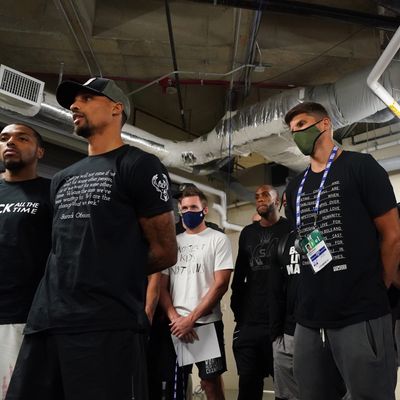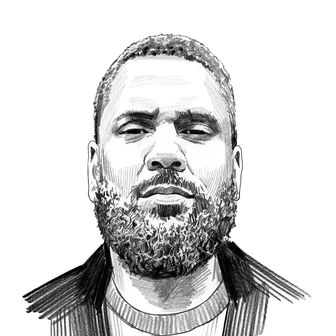
On paper, it looked like quarantine reimagined as a sports utopia: 322 of the world’s best basketball players, living in plush hotel rooms at Walt Disney World in Bay Lake, Florida — “the Most Magical Place on Earth” — and lounging poolside in between televised bouts for national primacy. But inside the “NBA Bubble,” the league’s tightly monitored coronavirus isolation zone, it proved impossible to keep the turbulent world at bay, and most of its residents didn’t want to.
With the pandemic ravaging and protests against police violence turning the country on its ear, the players restarted their season in July on the condition that giving voice to pressing social issues would be a top priority, and league brass agreed. The impetus to do so has only intensified since. New instances of brutality and deferred resolution in others are a constant reminder of what players are missing in isolation. “I want to go protest,” Jaylen Brown of the Boston Celtics wrote on Twitter on Tuesday, two days after his team swept the Philadelphia 76ers out of the playoffs. Now, continuing abuses by law enforcement have collided with the Bubble’s unusually communal environs to produce one of the biggest labor strikes in league history, which brought much of the sports world to a standstill earlier this week. The Milwaukee Bucks players’ refusal to participate in Wednesday’s games, and four other teams’ plans to follow suit, has been greeted with the usual derision from right-wing politicos, including Jared Kushner, who continue to view protesting athletes as coddled prima donnas and anti-patriots. But its very occurrence is a testament, first and foremost, to how voraciously brutal America’s policing culture had to be for hundreds of the country’s best-paid and most beloved Black celebrities, and their non-Black teammates, to break their labor contract and buck one of professional sport’s most durable precepts: the expectation that success would buy their silence.
Much is still unclear about the next steps. Talks are ongoing about the terms that would let gameplay resume in the coming days — despite the wishes of the Los Angeles Lakers and Clippers, who voted on Wednesday to suspend the season altogether. That the other teams wanted to keep playing would appear to limit how widely the strike might spread, and how long it will last, at least within the NBA context: Waves of dissent have since gripped the MLB, MLS, and professional tennis; WNBA players have continued their practice of demonstrating against recent racial inequities, which predates the NBA’s. But according to reports, the terms being discussed by the league and players involve developing a shared commitment to combating racism and greater flexibility around how and where players can make political statements without facing reprisal. As of now, the NBA’s most visible engagement with the protests has entailed letting players choose from a carefully curated list of phrases — from “Black Lives Matter” to the more anodyne “Group Economics” and “Education Reform” — to display on the backs of their jerseys, then flooding TV broadcasts with often-stilted proclamations that Black lives matter to the league, too. (The league and players’ union also agreed to the following terms before the restart: a commitment to “increase Black representation across team staff, front offices and in the league office; work with more Black-owned businesses and vendors; and form a foundation that would aim to ‘expand educational and economic development’ in Black communities,” according to ESPN.)
But the current demand that more be done is not limited to league executives. In the statement that kicked off Wednesday’s strike, the Bucks cited Jacob Blake, who was shot seven times in the back by police in Kenosha, Wisconsin, on August 23, while his children looked on. The team called for the officers involved to be “held accountable”; for the Wisconsin legislature to reconvene and pass “meaningful measures” to address brutal policing; and spoke with Lieutenant Governor Mandela Barnes and Attorney General Josh Kaul, both Democrats, to determine how they might help resolve the case. “They just wanted to know what they could do,” Barnes told ESPN about the players. “They wanted the walkout to be step one.” The lieutenant governor told them to “press for action at every level of government.” So far, the Republican-controlled Wisconsin legislature has declined to vote on a policing-reform bill pushed by Governor Tony Evers in June, prompting Kaul to quip, “The Bucks have, frankly, done more to address these issues than [Assembly Speaker] Robin Vos or [State Senator] Scott Fitzgerald.”
The crisis they’re up against is comprehensive. The feckless behavior of Wisconsin Republicans is fueled by their insulation from democratic will — a result of partisan gerrymandering that’s given them control over 64 percent of state assembly seats despite winning just 46 percent of votes in the last election. This incongruity allowed them to force April’s only in-person U.S. election — a transparent bid to secure partisan advantage ahead of a crucial state Supreme Court race. (It didn’t work; progressive Jill Karofsky won despite GOP hopes that endangering the lives of voters in large population centers, where Democrats have an advantage, would deter people from turning out.)
These dire circumstances are only magnified in the conduct of local law enforcement. The Milwaukee Police Association, the union representing the city’s police officers, recently endorsed President Trump for reelection, affirming the broader disdain toward popular will that has become a hallmark of police unions nationally. For 15 years ending in 2017, the Milwaukee County Sheriff’s Department was led by David A. Clarke, a right-wing conspiracist and eventual Trump surrogate who spent much of his tenure letting prisoners be raped, tortured, and die horrible deaths in his jails. Law-enforcement officials in Kenosha have left no doubt as to why their actions might spark protests and rioting, even besides their assault on Jacob Blake. In February 2018, Kenosha County sheriff David Beth remarked after a shoplifting bust, in which all five suspects were Black, that “some people aren’t worth saving” and should be locked away in “warehouses” to stop them from “going out and getting ten other women pregnant and having small children.” Kenosha police chief Daniel Miskinis blamed Wednesday’s murder of two protesters by 17-year-old Kyle Rittenhouse on the demonstrators’ refusal to obey a police-imposed curfew. This remarkable attitude was demystified when footage surfaced of Kenosha police officers handing out water to Rittenhouse and other armed militia members, thanking them for their presence shortly before the fatal shooting.
The persistence of this behavior nationwide helps explain the NBA’s involvement, and the mounting pressure players feel to engage with these issues actively. Six years ago, activists and family members were frustrated that LeBron James wouldn’t speak out against the police slaying of 12-year-old Tamir Rice, who was killed in Cleveland. Since then, he has become one of the league’s most vocal proponents of anti-racism causes and is joined regularly by others; a 2017 ESPN interview where he and Kevin Durant discussed the challenges of being Black public figures prompted Fox News’ Laura Ingraham to retort, “It’s always unwise to seek political advice from someone who gets paid $100 million a year to bounce a ball. Keep the political comments to yourselves … Shut up and dribble.” (The phrase was adopted as the title of a documentary that James executive-produced about athlete-activists.) In many ways, James is emblematic. The shift marks an evolution, of sorts, within a league that tolerated former Clippers owner Donald Sterling’s bigotry for decades before expelling him and that maintains a lucrative licensing partnership with China that’s made its members indefensibly reticent to speak out against that government’s abuses, particularly toward dissidents in Hong Kong and ethnic minorities in Xinjiang. Today’s flex of labor muscle — the future threat of which could reshape the dynamic between the athletic and political spheres for years to come — has boundless application if so chosen.
But perhaps most immediately, this dissident fervor among the players speaks to how thoroughly American law enforcement has negated their ability to regard police abuse as abstract — or as a vestige of circumstances or neighborhoods they escaped but feel little obligation to revisit. Fame and fortune have not granted the players the insularity that Ingraham and Kushner presume. New York City recently agreed to a legal settlement for $4 million with former Atlanta Hawks forward Thabo Sefolosha after NYPD officers arrested him and broke his fibula while clearing the sidewalk outside a nightclub in 2014. In 2018, Milwaukee police attacked Bucks guard Sterling Brown after he parked illegally at a Walgreens; they threatened him with their firearms, forced him to the ground, kneeled on his leg, and used a Taser on him. In 2019, Alameda County, California, sheriff’s officials arrested Masai Ujiri, president of the Toronto Raptors, and claimed he’d assaulted a deputy while trying to make his way onto the court at Oracle Arena to celebrate his team’s championship. Newly released video footage shows this story to be a lie; Deputy Alan Strickland assaulted Ujiri without provocation, shoving him in the chest several times before the Raptors president pushed him back.
Taken together, these interactions suggest an appetite for brutality that, although it mostly targets marginalized people, refuses to limit itself to them alone. If there’s a world where the privilege of being an NBA star renders police violence theoretical, officers across the country have found abundant ways to circumvent it, especially in recent years. Paired with their abuses that grace news feeds daily, the result is an impressive achievement — not only encouraging rich athletes to find common cause with the reviled and the criminalized, but to do so on a subject, policing, that will earn them seething vitriol from millions of white Americans. That it has come to this, and made the associated risks seem worthwhile, speaks to the unique capacity for political action facilitated by the NBA Bubble and the inability of police to make pursuing it a harder decision.






























